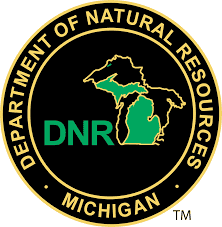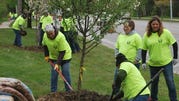Herman Lunden Miller inherited only one thing from his grandfather, Michigan forestry pioneer Herman Lunden: his eyeglasses. They’re on a shelf in Miller’s home office in an Ann Arbor senior center, but he plans to soon give them to his cousin Pat Lunden.
“My mother kept them on top of her fireplace, and I suppose she figured she had to do something with them, so she gave them to me,” Miller said. “They’re all that I have of my grandfather’s personal effects, but I don’t need them. I think Pat will probably get the best use out of them at the museum she’s working on.”
That museum is the Pigeon River Country Discovery Center, opening in summer 2018 in the Pigeon River Country State Forest near Gaylord. It will be situated in a massive 1930s-era log cabin near the park’s visitor center and will feature an exhibit about Lunden (pronounced luhn-DEEN), who helped set the tone for the second part of the three essential phases of change in Michigan’s forest land.
The first phase involved the harvesting of virgin forests, from about 1830 to the late 19th century. Lunden was an instrumental part of the second phase, which began the process of regrowth of cleared land, including replanting and dedicating large tracts of land to permanent forest preserves. The third step – actively managing forests for multiple uses and developing surrounding rural lands to support that management – continues to this day.
The Pigeon River Country Discovery Center is dedicated to the state’s history of forestry, which is the science, art and practice of sustainably managing forests and all their resources to benefit humans, wildlife and the environment. Miller, who will be 94 by the time it opens, said he hopes to be able to visit it.
“It’s hard for me to get around now, but I really enjoy being out in the woods,” Miller said. “I love communing with nature, especially in that part of the state where my grandfather spent so much of his life.”
Pioneering patriarch
Genealogy is a hot topic, due largely to a crop of new reality TV shows dedicated to the science, as well as apps, DNA kits and websites that make it easy for people to explore their family histories. Miller said he had never thought much of genealogy, but became enamored with it after deciding to write a biography on Lunden.
He spent months sifting through boxes of his grandfather’s business papers to write his 1999 book, “Biography of Herman Lunden, Lumberman and Conservationist,” which covered his grandfather’s life. It includes specifics about Lunden’s personal life – he had an “exuberant personality and a quick temper,” and he loved horses – as well as his professional accomplishments. Miller found that his grandfather’s work didn’t go unappreciated in his time.
“My mother always talked about him, and after I read his obituaries, I began to see what an interesting man he was and how much he did for the state of Michigan,” Miller said. “And people seemed to really like him. I felt like this needed to be done.”
Lunden was born in Sweden in 1859 and immigrated to the U.S. with his parents when he was 20 years old. He moved to Bay County, where his half brother, John, lived at the time. Lunden started to work in local sawmills, lumberyards and railroads, eventually moving his way up to director positions at several lumber companies and becoming the president of multiple banks.
Herman Lunden was one of Michigan’s earliest forestry advocates, and he fought to keep northern Michigan dedicated to trees rather than be turned over to farmers after it was clear-cut in the early 20th century. His expertise included sawmill operations, banking, road building and conservation efforts.
“My sincere hope is that the Conservation Department will build up their Fire Organization and Reforestry Program,” Lunden wrote in his 1927 autobiography, envisioning a future Michigan full of healthy, well-maintained forests. “If this is done, we will have both game and fish.”
Lunden was also one of the founding members of the Michigan Conservation Commission, a forerunner of today’s Michigan Department of Natural Resources. He was part of the first set of Michigan outdoorsmen who realized that Michigan’s forests required active management – including cutting trees, planting new ones, holding prescribed burns, fighting disease and monitoring and controlling invasive species – to keep them sustainable.
“Years before this was a science, my grandfather understood the basics of forestry, which included cutting down some trees to ensure the forest would stay healthy,” Miller said. “Now this is all common knowledge, but he was way ahead of his time.”
Trees are a renewable resource, and every year about twice as much wood in Michigan is grown than harvested. The DNR follows a set of rules to protect forests and makes sure the right number of trees are cut down to balance the needs of people and animals – it is science, after all.
Miller didn’t pursue a career in forestry. He opted for a career as a physicist, which included working on the Apollo space program. Although he initially rebuffed the idea that he inherited anything from his grandfather (besides those eyeglasses), he copped to possibly possessing Herman Lunden’s legendary problem-solving skills.
“He was really quite adept at observing the entirety of a situation, determining what the problem was, and then figuring out a solution,” Miller said. “He had a scientist’s mind. I guess we’re similar in that way.”
‘Long history of land stewardship’
Although Miller didn’t have any children of his own, his late cousin John Lunden (who was Pat Lunden’s husband) had three kids who carry on the family name. One of those children is Susan Lunden, chief operating officer of the National Audubon Society, one of the nation’s longest-running nonprofit environmental organizations dedicated to conservation. She spent a career honing her business skills in the upper echelons of the New York publishing world before transitioning to the nonprofit sector.
“My family has a long history of land stewardship, which has played out differently for every one of us,” Susan Lunden said. “My dad was a lifelong member of Ducks Unlimited, and even though my brothers and I don’t hunt or fish, our family cottage in Lewiston is still a big part of our family.”
Lunden said she appreciates her great-grandfather’s work in forestry, and recognizes that it directly influenced the birth of the practice in Michigan. She said part of the reason she transitioned to conservation was because she wanted to spend her time doing something that “made a difference.”
“I wanted to devote my business skills to making the world a better place, and climate change resonated with me,” she said. “Land stewardship is an important part of my values, so if I can’t be a biologist or an activist, I can make sure that Audubon is operating at maximum efficiency. That’s my contribution.”
The Lunden legacy
Herman Lunden died suddenly in 1929, moments after giving a speech advocating the paving of M-76, a precursor to I-75 that still runs between Standish and West Branch. From his obituary, which referred to Lunden as “Northern Michigan’s Grand Old Man”:
“He responded in his usual optimistic talk, closing by stating that it had been his desire to see his beloved Northern Michigan ‘come back’ and that he felt it was now doing that. He said that it was also his desire to see the younger generation take up the work of those who would soon be compelled to lay down the working tools, and that he himself felt that he had not many years to carry on.”
Lunden then returned to his seat, sat down and crumpled in his chair. Despite the work of several physicians in attendance, “the spark of life had flickered and died, never to be turned into the dynamic glow it had burned with for many years.”
Miller was just 4 when his grandfather died, and his only memory of him was having to keep quiet while he slept on the couch. Still, Miller said his work on his book helped him connect with the man who “insisted” that he, his first grandson, be named after him, and who played such an important role in Michigan’s forestry movement.
“It’s a shame he isn’t more well-known, but maybe his exhibit at the museum will help,” Miller said. “I think it’s great that they’re doing that. Hopefully it will help people realize that these forests needed the hard work of people like my grandfather to be here today.”
Sustainable and healthy forests are important to every Michigan resident. The practice of forestry not only manages disease and promotes the growth of new trees, it also creates healthier habitats for wildlife and gives us a place to hike, camp, hunt, fish and make memories. Thanks to the work of Lunden, Michigan will continue to have healthy forests for generations to come.
Members of the editorial and news staff of The Detroit News were not involved in the creation of this content.




